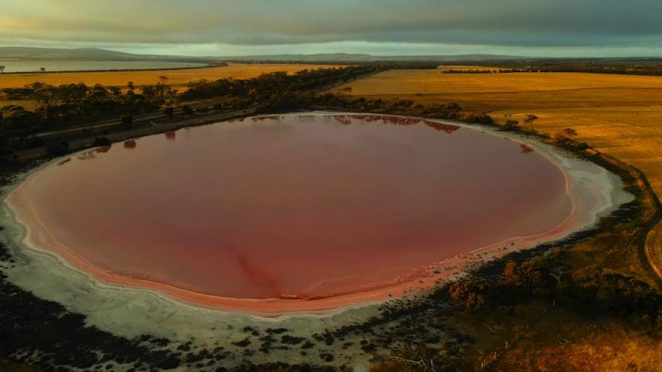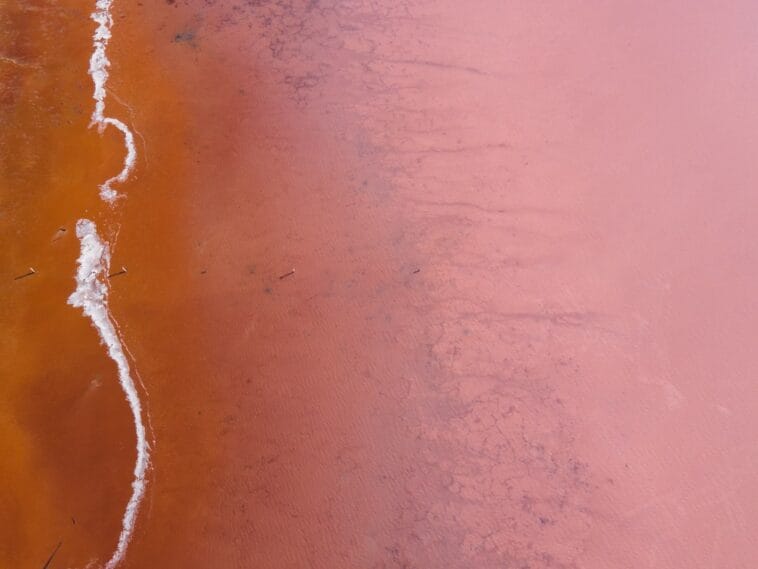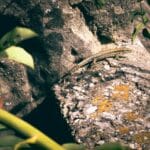Nestled within the rugged landscapes of Utah, Pink Lake stands as a striking natural wonder that captivates visitors with its vibrant hues and serene beauty. This unique body of water, often referred to as a hidden gem, is renowned for its stunning pink coloration, which creates a surreal contrast against the surrounding desert terrain. The lake’s ethereal appearance draws photographers, nature enthusiasts, and curious travelers alike, all eager to witness the breathtaking spectacle that seems almost otherworldly.
The lake’s allure is not merely aesthetic; it serves as a reminder of the intricate interplay between nature’s elements and the delicate ecosystems that thrive in such environments. The lake’s striking color is a result of various natural processes, including the presence of certain microorganisms and minerals that flourish in its saline waters. The vibrant pink hue can shift in intensity depending on the time of year and the weather conditions, creating a dynamic visual experience that changes with the seasons.
Visitors often find themselves enchanted by the lake’s beauty, which is accentuated by the surrounding landscape of red rock formations and expansive skies. This picturesque setting not only provides a feast for the eyes but also offers a tranquil escape from the hustle and bustle of modern life, making Pink Lake a must-visit destination for those seeking solace in nature.
Key Takeaways
- Pink Lake Utah is a natural wonder that captivates visitors with its stunning pink water and unique surroundings.
- The pink water of the lake is formed by a combination of high salinity and a special type of algae, creating a one-of-a-kind natural phenomenon.
- Pink Lake holds cultural significance for the indigenous people of the area, and has a rich history that adds to its allure.
- The flora and fauna surrounding Pink Lake are diverse and unique, providing a rich ecosystem for visitors to explore and appreciate.
- Visitors can enjoy a variety of activities at Pink Lake, including hiking, birdwatching, and photography, making it a popular destination for nature enthusiasts.
The Unique Formation of the Pink Water
The High Salinity Environment
The lake is characterized by its high salinity, which is significantly greater than that of typical freshwater bodies. This elevated salt concentration creates an environment conducive to the growth of halophilic microorganisms, particularly certain species of algae and bacteria.
The Role of Microorganisms
These microorganisms thrive in saline conditions and produce pigments that contribute to the lake’s vibrant coloration. For instance, Dunaliella salina, a type of green microalga, is known for its ability to produce beta-carotene, which imparts an orange-red hue to the water when present in high concentrations.
A Dynamic Ecosystem
In addition to microorganisms, the mineral composition of the lake plays a crucial role in its unique appearance. The presence of salts such as sodium chloride and magnesium sulfate can influence the color and clarity of the water. During periods of evaporation, which are common in Utah’s arid climate, these minerals become more concentrated, further enhancing the lake’s striking pink coloration. The interplay between biological activity and mineral content creates a dynamic ecosystem that not only supports life but also contributes to the lake’s ever-changing visual spectacle.
The History and Cultural Significance of Pink Lake

The history of Pink Lake is intertwined with the cultural narratives of the indigenous peoples who have inhabited the region for centuries. Native American tribes, including the Ute and Paiute, have long regarded this area as sacred ground, rich with resources and spiritual significance. The lake’s unique characteristics have inspired various legends and stories that reflect the deep connection these communities have with their environment.
For them, Pink Lake is not merely a geographical feature; it embodies a sense of identity and heritage that has been passed down through generations. In more recent history, Pink Lake has attracted attention from scientists and researchers interested in studying its unique ecosystem. The lake has become a focal point for ecological studies aimed at understanding extremophiles—organisms that thrive in extreme conditions—and their potential applications in biotechnology and medicine.
This scientific interest has further elevated the lake’s status as a site of both natural beauty and academic inquiry, highlighting its importance beyond mere aesthetics.
The Flora and Fauna Surrounding Pink Lake
| Flora | Fauna |
|---|---|
| Reeds | Birds |
| Algae | Fish |
| Saltbush | Reptiles |
| Blue-green algae | Insects |
The ecosystem surrounding Pink Lake is as diverse as it is fascinating, supporting a variety of flora and fauna adapted to thrive in its unique environment. The saline conditions create a habitat that is home to specialized plant species capable of tolerating high salt concentrations. Salt-tolerant plants such as pickleweed and saltgrass can be found along the shores, contributing to the ecological balance of the area.
These plants not only stabilize the soil but also provide essential habitat for various animal species. Birdwatchers flock to Pink Lake to observe migratory birds that frequent the area, drawn by the abundant food sources provided by the lake’s microorganisms. Species such as American avocets and black-necked stilts can often be seen wading through the shallow waters, while other birds take advantage of the surrounding wetlands for nesting and feeding.
The interplay between flora and fauna creates a vibrant ecosystem that showcases nature’s resilience and adaptability in challenging conditions.
Activities and Recreation at Pink Lake
Visitors to Pink Lake are greeted with a plethora of recreational opportunities that allow them to immerse themselves in this natural wonder. Photography enthusiasts often find themselves captivated by the lake’s stunning colors, particularly during sunrise and sunset when the light casts a magical glow over the water. The reflective surface creates mesmerizing images that are perfect for capturing on camera, making it a popular spot for both amateur and professional photographers.
In addition to photography, outdoor enthusiasts can engage in activities such as hiking and birdwatching along designated trails that wind through the surrounding landscape. These trails offer breathtaking views of Pink Lake from various vantage points, allowing visitors to appreciate its beauty from different perspectives. For those seeking a more leisurely experience, picnicking by the lakeside provides an opportunity to relax while soaking in the tranquil atmosphere.
The combination of stunning scenery and recreational activities makes Pink Lake an ideal destination for families, couples, and solo adventurers alike.
Environmental Conservation Efforts for Pink Lake

As awareness grows regarding the ecological significance of Pink Lake, various conservation efforts have been initiated to protect this unique environment from potential threats. Local organizations and environmental groups are actively engaged in monitoring water quality and biodiversity within the lake ecosystem. These efforts aim to ensure that the delicate balance between human activity and natural preservation is maintained.
One significant aspect of conservation involves educating visitors about responsible practices while enjoying the area. Initiatives such as guided tours and informational signage help raise awareness about the importance of preserving natural habitats and minimizing human impact on sensitive ecosystems. By fostering a sense of stewardship among visitors, these efforts contribute to the long-term sustainability of Pink Lake and its surrounding environment.
How to Visit and Experience Pink Lake
Visiting Pink Lake offers an opportunity to connect with nature in a truly unique setting. Accessing the lake typically involves traveling through Utah’s scenic landscapes, with several routes leading to this hidden gem. Travelers can plan their visit during spring or fall when temperatures are milder, making outdoor activities more enjoyable.
It’s advisable to check local weather conditions before embarking on a trip, as sudden changes can affect accessibility. Once at Pink Lake, visitors are encouraged to explore designated trails that provide access to various viewpoints around the lake. These trails vary in difficulty, catering to different levels of hiking experience.
For those interested in photography or simply soaking in the scenery, early mornings or late afternoons offer optimal lighting conditions for capturing stunning images of the lake’s vibrant colors against the backdrop of Utah’s dramatic landscapes.
The Future of Pink Lake: Preservation and Protection
Looking ahead, the future of Pink Lake hinges on continued efforts toward preservation and protection against environmental threats. Climate change poses significant challenges to ecosystems worldwide, including those found at Pink Lake. Rising temperatures and altered precipitation patterns could impact water levels and salinity, potentially disrupting the delicate balance that sustains its unique flora and fauna.
To safeguard this natural wonder for future generations, ongoing collaboration between local communities, conservation organizations, and governmental agencies will be essential. Initiatives aimed at promoting sustainable tourism practices can help mitigate human impact while fostering appreciation for this remarkable ecosystem. By prioritizing education and awareness, stakeholders can work together to ensure that Pink Lake remains a cherished destination for years to come, preserving its beauty and ecological significance for all who seek to experience its wonders.
If you’re fascinated by unique natural phenomena like Utah’s Pink Lake, you might also enjoy exploring other remarkable destinations around the world. For instance, Napoleon Island in Rwanda offers a breathtaking experience that is equally captivating. Located near the town of Kibuye, this island is known for its lush greenery and abundant birdlife, providing a stark contrast to the arid beauty of Pink Lake. To learn more about this enchanting Rwandan destination, you can read further details here.


